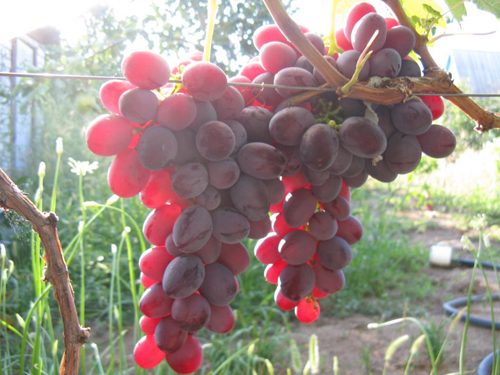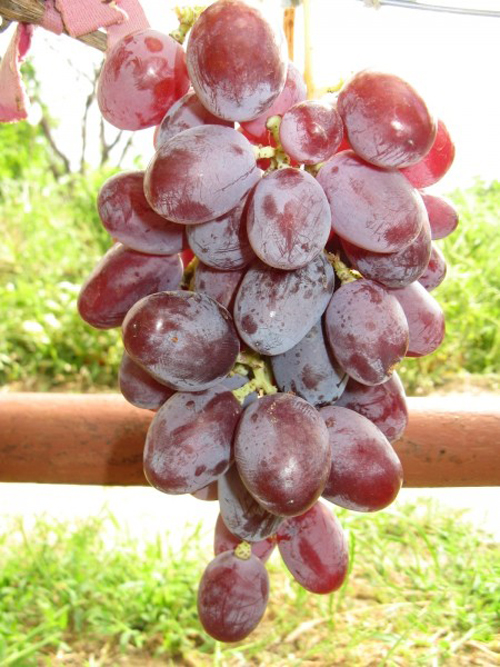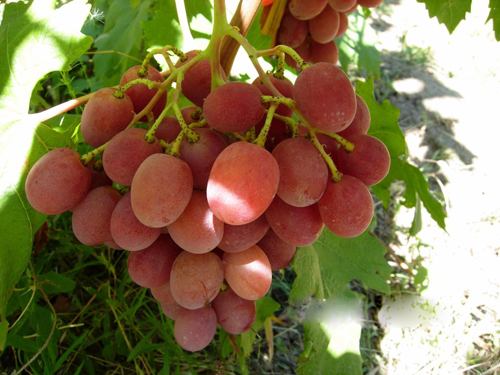Grape variety Ruby Jubilee
Ruby jubilee is a hybrid form of table grapes, bred by one of the founders of the national national selection, Viktor Krainov, from Novocherkassk. Since 1953, Viktor Nikolaevich has been growing sun berries on his site on the banks of the Tuzla River, and after decades of practical viticulture, he decided to also start breeding new hybrids. The first impetus to research activities and tremendous theoretical support along this path to Krainov was provided by the famous scientist from the All-Russian Research Institute of Viticulture and Winemaking Ivan Kostrikin. The result of a successful symbiosis of the carriers of a gigantic baggage of theoretical knowledge and practical experience was the emergence of many magnificent varieties, the best of which were even included in the State Register of Breeding Achievements of the Russian Federation. But those creations of Krainov, which did not receive such an honor, have become, for the most part, very popular among grape lovers and are currently growing on huge areas of farm and summer cottages.

One of these, widespread in amateur plantings of hybrids, is Ruby Jubilee - large-fruited grapes with berries of amazing color, taste and aroma. It got its name in connection with the 40th anniversary of the married life of Viktor Nikolaevich with his second half. This round date is popularly called the ruby wedding. The author presented his wonderful novelty as a gift to his wife.
The parental pair of this grape variety became the breeder's favorites - varieties Mascot and Radiant kishmish... The first is distinguished by the gigantic size of bunches and berries, relative resistance to disease and frost, as well as a functionally feminine type of flowering, which makes it very convenient for enthusiastic researchers. The second representative of the pair - Radiant Kishmish, was responsible for the magnificent aesthetic and taste qualities of the future offspring. This combination of crossing turned out to be almost the most productive for Krainov - at different periods of time he identified several promising hybrids through it at once, including his famous "three" - Transformation, Anniversary of Novocherkassk and Victor... And here it is worth noting that the Ruby Jubilee absolutely does not lag behind its illustrious counterparts, and even surpasses them in some positions, in particular in terms of a wonderful aroma.
Agrobiological characteristics of the variety
Plants are above average vigor. The crown of a young shoot is green with a slight cobweb pubescence. The grape leaf is rather large, dark green, round, five-lobed, strongly dissected, with a flat and smooth surface. The upper lateral notches are deep, usually open, lyre-shaped, with a rounded bottom, sometimes with a denticle at the bottom. The lower incisions are of shallow depth, varied in shape: from vaulted with a similar bottom notch to the upper, to V-shaped, and even barely outlined. The petiole notch is open, broadly vaulted, with a flat-pointed bottom. The petiole is green, of medium length. The denticles along the edge of the leaf are well-developed, saw-like, with smooth edges and sharp tops, different in size. The flowers of the variety are bisexual, confidently pollinating with their own pollen, but having a tendency to shedding in rainy weather during flowering. The maturation of the Ruby Jubilee vine is good.

Bunches of large and very large size, cylindrical-conical, moderately dense, weighing from 600-800 grams (medium), up to 2 kg (maximum). In case of significant shedding of buds during flowering, the brushes may be incomplete and very loose. The stems of the ridges are long, well developed and strong, green in color with a slight pink tint. The berry is large, oval or oval-cylindrical, with an average length of 32 mm, a diameter of 24 mm, and weighing 8-12 grams.The grapes are distinguished by a fairly aligned caliber on the bunch, they do not show signs of peas. The pulp of grapes is of medium density, juicy and fleshy, with a pleasant harmonious taste and a well-pronounced nutmeg aroma, which significantly increases its tasting characteristics. The skin is rather thin, light when chewed, painted in an elegant pink color, the intensity of which, like many Kraynov varieties, depends on the air temperature during the ripening period and the sun exposure of the bunches. The surface of the berry is covered with a smoky waxy bloom. Freshly squeezed uncolored juice. Its sugar content is 16-17 grams / 100 cubic meters. cm, titratable acidity - 5-6 grams / liter. There are 2-3 seeds in the berry, but due to their medium size and significant pulp volume, they are not too noticeable during the tasting. The gastronomic characteristics of the Ruby Jubilee are consistently high, many recognize it as one of the most delicious modern hybrid forms.
It is most advisable to use grapes for eating fresh, however, in the case of a rich harvest, its surplus can be successfully used for processing into aromatic juices, compotes and jam. For winegrowers who cultivate crops for commercial purposes, the Ruby Jubilee will undoubtedly be interesting due to the attractiveness and high marketability of its fruits. It ripens a little later than the famous varieties of the Kraynovskaya "troika", and can take its rightful place in the "conveyor" of large-fruited pink-colored varieties, thereby extending the period of their continuous sale. The transportability of the bunches is quite sufficient for long-distance transportation, and they are well adapted to storage, especially in optimal conditions of refrigerating chambers.
The grape harvest reaches mass ripeness in the early-middle period - in the south, in the third decade of August. At the same time, the growing season, counting from the moment of bud break, lasts 115-125 days. The demand for heat, expressed in terms of the sum of active temperatures, is 2500-2600 ° C. For comparison, a similar level of SAT is typical for the latitude of Kaliningrad, Kaluga and Ryazan, which makes it quite possible to grow and stable maturation of the Ruby Jubilee in these parts, provided that the plants are protected from winter cold. The frost resistance of the hybrid does not exceed -23 ° C, which makes it possible to cultivate it without shelter only in the southern regions of the country.

The potential yield is quite high - up to 15-20 kilograms from a well-developed adult bush, while the real one depends on a set of factors associated with proper care and favorable weather conditions, especially during the flowering period of grapes. The variety is highly prone to overloading, which must be borne in mind by every grower cultivating it. Already ripe bunches can continue to hang on the bushes for quite a long time without reducing the presentation and taste. However, due to the presence of conflicting information about the resistance of berries to cracking, it will not be superfluous to secure the harvest by timely collection in dry years, when unexpected precipitation can lead to a sharp drop in soil moisture and subsequent damage to the fruit. Berries also need protection from wasps, of which the most reliable option is to place the bunches in individual mesh bags.
Agrotechnical features
It can be stated with confidence that the cultivation of the Ruby Jubilee is not an overly difficult task and is within the power of most winegrowers who have a basic understanding of the agricultural technology of table grapes. At the same time, in order to obtain the highest quality harvest, increase its volume without harming productive plants, it is necessary to take into account a certain specificity that a variety presents to self-care.
Bushes grow equally well, both on their own roots and in a grafted culture. The rooting rate of cuttings and intergrowth with various rootstocks in the hybrid is good, the choice of the propagation method determines only the presence of a dangerous pest in the soil - the root phylloxera.In areas of its infestation, self-rooted plants can die within a few years after planting, which is why planting seedlings grafted on phylloxera-resistant rootstocks is required in these places. The nutritional area of a grape bush when planting plantings should be 4-6 square meters. meters.
The growth and development of the Ruby Jubilee is quite active, however, on insufficiently fertile soils for the earliest entry into full-fledged fruiting, it requires additional feeding, providing a significant annual increase in wood. Formation depends primarily on climatic conditions and the need to shelter the vine for the winter. In traditional regions where grapes grow, where there is no significant risk of freezing of the aboveground part in winter, the bushes form on a high trunk with powerful arms and cordons. In such conditions, they will show their strongest qualities and will endow them with numerous, large in size, sweet and very fragrant bunches. If there are concerns about the sufficient frost resistance of the variety, you can simultaneously create an additional lightweight lower tier, which will shelter for the winter and serve as a reserve. In the same places where winter temperatures regularly drop below - 23 ° C, full-fledged warming of plants is necessary, and therefore they are formed without a stem, usually according to the scheme of an oblique cordon or a multi-arm fan. The insulating layer can be both the soil itself and organic materials - sawdust, straw, spruce branches or reed mats. Good results are also shown by the construction of film tunnel shelters like mini-greenhouses.
Due to the pronounced tendency of the Ruby Jubilee to overload, high-quality rationing of the grape bushes is required. The number of eyes left during spring pruning depends on the chosen formation and the total vital energy of the plant, ranging from 30 to 45. Fruit arrows are recommended to be shortened by 8-10 buds. After the fragments of weak and sterile shoots, the number of fruitful shoots should be 20-24 pieces, on which, after the appearance of the ovary, one, the strongest bunch, must be left. Thinning of brushes at the flowering stage is not recommended for this variety, so as not to aggravate the existing predisposition to shedding of inflorescences. Moreover, in order to reduce the harmfulness of this negative distinctive feature, it is advised to pinch the fruitful shoots before flowering, as well as to use specialized preparations and chemical compositions that reduce the likelihood of shedding grape inflorescences.
The fight against diseases at the Ruby Jubilee should be carried out quite seriously, since the variety has an average resistance to them. It is imperative that preventive treatments from mildew and oidium be carried out before and after flowering, and then repeated at the first symptoms of plant damage by pathogens. With wasps, as already mentioned, a fight should also be waged and the protection of ripening clusters from these insects should be carried out. Cracking and subsequent decay of berries can be prevented if you monitor the water regime of the soil, watering the bushes in time, preventing excessive drying of the soil under them.
With regard to the intensity of the color of mature brushes, the Ruby Jubilee exhibits the same properties that are characteristic of other forms of selection by Viktor Krainov, obtained on the basis of crossing the Talisman and Radiant Kishmish. So, the most elegant color of berries is formed on shaded bunches, especially in a temperate, not too hot climate. In the sultry summer in the south, with active insolation, the harvest is literally baked, without having time to acquire its rich pink color, as it happens without any problems in non-traditional regions of northern viticulture.In this regard, fans of this variety can only be advised not to abuse the clarification of grape bunches during their ripening period, or even completely abandon this procedure, and even work on creating additional shading of the fruit zone of the bush, thus achieving not only a large, tasty and aromatic harvest, but also insanely attractive in appearance.








